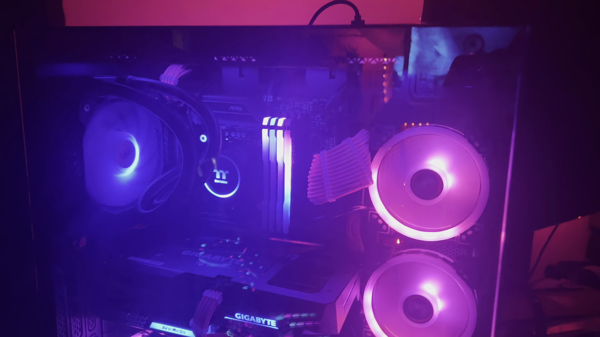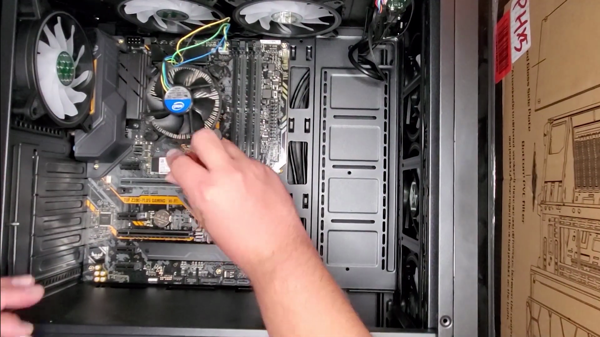Note: As an Amazon Associate I earn from qualifying purchases.
Building a pc the MUSETEX K2 ATX PC Case ARGB Fans Black: my experience (2024)
Introduction
I recently got my hands on the MUSETEX K2 gaming case. As a gamer and desktop builder, I appreciate both aesthetics and functionality of cases. Below I get deeper into the design, cooling, build quality, and compatibility of the K2.
Specifications
| Property | Value | Property | Value |
|---|---|---|---|
| Brand | MUSETEX | Case Type | Mid Tower |
| Recommended Uses For Product | Gaming | Color | Black |
| Material | Tempered Glass, Plastic, Metal | Cooling Method | Water, Air |
| Light Color | RGB | Item Weight | 8 Kilograms |
| Product Dimensions | 16.57”D x 9.06”W x 18.05”H | Number of USB 3 Ports | 2 |
Photos
Click on photos to enlarge them:
Prices
Check prices of the MUSETEX K2 ATX PC Case ARGB Fans Black on:
Design and Aesthetics of the MUSETEX K2

The MUSETEX K2 stands out to me for a few reasons when it comes to design and aesthetics. When building a gaming rig, you want it to not only perform well but also to look good, right? Here’s my take on the look and feel of this case.
Firstly, the 270° dual tempered glass panel is a bold move. It gives a panoramic view of the internals which showcases those RGB components and custom builds – a big plus for those who like to show off their handy work. It’s not just about visibility; the glass adds a premium touch too. However, this could be a drawback for some – glass panels are fingerprint magnets and may require regular cleaning to keep them pristine.
The six pre-installed PWM ARGB fans are a major highlight. Straight out of the box, you’ve got a light show ready to go. It’s pretty cool to have software control for lighting customization. Granted, it might not offer the granularity that some hobbyists want when it comes to individual fan color controls, but for many, the out-of-the-box lighting profiles will do just fine.
Here’s a quick breakdown of the design positives and potential negatives:
Pros:
Sleek dual glass panel design offers a great view of the components.
Six ARGB fans included, which is generous at this price point.
The case lighting syncs with various motherboards for a unified aesthetic.
Cons:
Glass panels need regular cleaning to prevent smudges.
The front glass panel could restrict airflow slightly.
On to practicality, the case doesn’t eat up much desk space despite its roomy interior. The sleek black metal gives off a cool, understated vibe. However, let’s be real – as beautiful as it looks, the glass design doesn’t bode well for clumsy folks or high-traffic areas where a bump could spell disaster.
Lastly, customer support stands out to me. Knowing that there’s help if something goes wrong adds a level of confidence to the purchase. It’s comforting to see a brand engaging with their users post-sale, especially for troubleshooting.
In summary, the MUSETEX K2 case ticks many boxes for gamers looking for a combination of performance and aesthetics in their build. It may have some minor design quirks, but the positives strongly shine through. Whether you’re a seasoned builder or a newbie, it seems like a solid choice to house your PC components stylishly.
Cooling Efficiency and Airflow Mechanics

When exploring the cooling efficiency and airflow mechanics of the MUSETEX K2 case, several key qualities stand out that are vital for optimal PC performance. Here’s my take on what works and what doesn’t:
Pros:
Six pre-installed PWM ARGB fans suggest a focus on achieving substantial airflow right out of the box.
Design permits a beneficial air intake channel through the strategic placement of side fans, increasing overall cooling efficiency.
Versatile fan support enables customization for those interested in tweaking their cooling setup.
Cons:
The front glass panel may restrict airflow slightly, despite the aesthetic appeal, because it channels air intake through limited slits.
Pre-installed fans are daisy-chained and motherboard-controlled, which may be a drawback for users wanting more customized RGB setups.
The K2’s cool factor is undeniable, pun intended. With those six fans and the possibility for a top-mounted 360mm radiator, there’s a lot of potential here to keep high-end hardware cool. While the fans use anti-vortex blades to ensure proper airflow, it’s the way they’re controlled via software that allows for a flexible cooling regime—tailored to the user’s needs.
However, I’ve noticed a potential hiccup when it comes to the front panel design. While the dual tempered glass contributes to the sleek look of the case, it appears to limit airflow into the case. Gamers who push their systems to the max might need to keep an eye on temperatures, especially if they’re overclocking or running demanding applications.
Another thing I’ve considered is the inclusion of magnetic dust filters. They’re a nifty addition to combat dust build-up, but given the case’s many unfiltered openings, their efficacy might be less than ideal. I’m left wondering if these will catch dust only on the way out, rather than stopping it from getting in.
One of the aspects I appreciate is the dedicated PSU space and cooling channel. It’s not just a thoughtful touch for aesthetics and noise reduction, but also a strategic move for better airflow management and component longevity.
From a personal perspective, I reckon the K2 is at its best when used by those who don’t plan to fiddle too much with intricate RGB setups or who need extreme custom cooling solutions. For the general gamer, this case provides ample space, a fair cooling system, and the ability to show off your build with a side of flashiness. However, for the more demanding users, the K2 may require some airflow modifications or fan upgrades to ensure everything stays chilly during intense gaming sessions.
Build Quality and Material Composition

The build quality of the MUSETEX K2 strikes me as a mix of both resilience and elegance where it counts. Constructed primarily from tempered glass, metal, and plastic, you get a sense that this case isn’t just another run-of-the-mill offering. The metal frame feels sturdy, offering a reassuring foundation that suggests it can handle the occasional nudge without warping or denting. Also, the tempered glass panels add an air of premium touch, yet, they are robust enough to not crack under slight pressure.
That said, let’s hash out the materials a bit:
Tempered Glass: High translucency for that aesthetic appeal, tough for durability but could be a fingerprint magnet.
Metal: The main structural material which gives the case its solidity; the black matte finish adds to the visual pop.
Plastic: Used in less critical areas, like the front I/O panel; not as durable, but keeps the costs down.
I do have mixed feelings about the plastic’s quality. On one hand, it helps maintain an affordable price point, but on the other, it lacks the substantiality I’d expect from a high-end case.
Now, nudging the positives, the side panels transmit light impressively well, which is crucial for those serious about showcasing their rig’s internals. The magnetic dust filter is another high point for me. It’s practical and doesn’t fall off at the slightest touch, which is a plus for long-term usability.
However, it’s not without its drawbacks. While the novelty lighting is a sight to behold, the control system feels like an area that could use more polish. The lights don’t remember your settings after shutdown, possibly causing some annoyance for users who want a set-and-forget system. Also, the reliance on a 3-pin connector for the RGB fans might limit your motherboard choices unless you’re considering a converter or reaching out to the company for advice.
In terms of practical implementation, things are mostly favorable. The I/O panel comes with a sufficient number of USB ports, including a Type-C, which is a nod towards future-proofing.
While no case is perfect, the MUSETEX K2 seems to understand its audience. It’s designed to be striking without compromising on the core elements of function. For those looking for a balance between cost and features, with a leaning towards the more positive aspects of build and material quality, it’s an option worthy of consideration. Sure, some might find quirks with the inclusion of plastic components or nuanced lighting controls, but these are relatively minor and do not detract significantly from the overall value proposition.
Compatibility and Hardware Support

When it comes to the MUSETEX K2, compatibility and hardware support are key factors to consider. I have to say, the roominess inside this case is impressive. You can fit ATX, Micro-ATX, and Mini-ITX motherboards with ease, and there’s plenty of breathing room for high-end GPUs up to 420mm. That’s more than enough for that beefy graphics card many of us dream about.
Here’s a quick rundown of the hardware support:
GPU Length: Generous space supports cards up to 420mm, which means even GPUs like the RTX 3090 have ample space.
CPU Cooler Height: With support for coolers up to 176mm, that leaves room for most air coolers comfortably.
PSU Length: Room for PSUs up to 238mm—sufficient for most power supplies on the market.
But it’s not all sunshine and rainbows. If aesthetics matter to you, you might find the visibility of the HDDs a bit of an eyesore since there’s no option to hide them without extra work. Also, be aware that the front fans draw air from slits on the sides of the tempered glass, which may slightly restrict airflow.
However, the pre-installed PWM ARGB fans are a big plus, allowing for easy control through the motherboard for a synchronized light show. A minor inconvenience is that the RGB controls don’t save your settings after shutdown, so you’ll have to reset them each time you power on. But that’s a small price to pay for the overall functionality.
Cable management could be a bit better, though. With my build, rerouting fan cables was necessary to maintain a clean look. And then there’s the issue of compatibility with cooling setups—while there’s support for several fan and radiator sizes, if you have a specific custom cooling loop in mind, you may need to do some tweaking to get everything to fit just right.
On the plus side, the PSU shroud is great for hiding cables and the PSU itself. It’s a thoughtful detail that helps maintain a clean build. For anyone who’s into DIY mods, the case provides a good basis to start with. But, if you’re not, you might knock off a point for the extra effort needed.
Overall, my experience is different from other cases because the details MUSETEX provides, like the independent cooling channels and the strategic placement of dust filters, really show a focus on durability and performance. And even when there are drawbacks, I’d say the K2’s roominess and expansion capabilities far outweigh them, especially if you’re planning a build that you may upgrade in the future.




